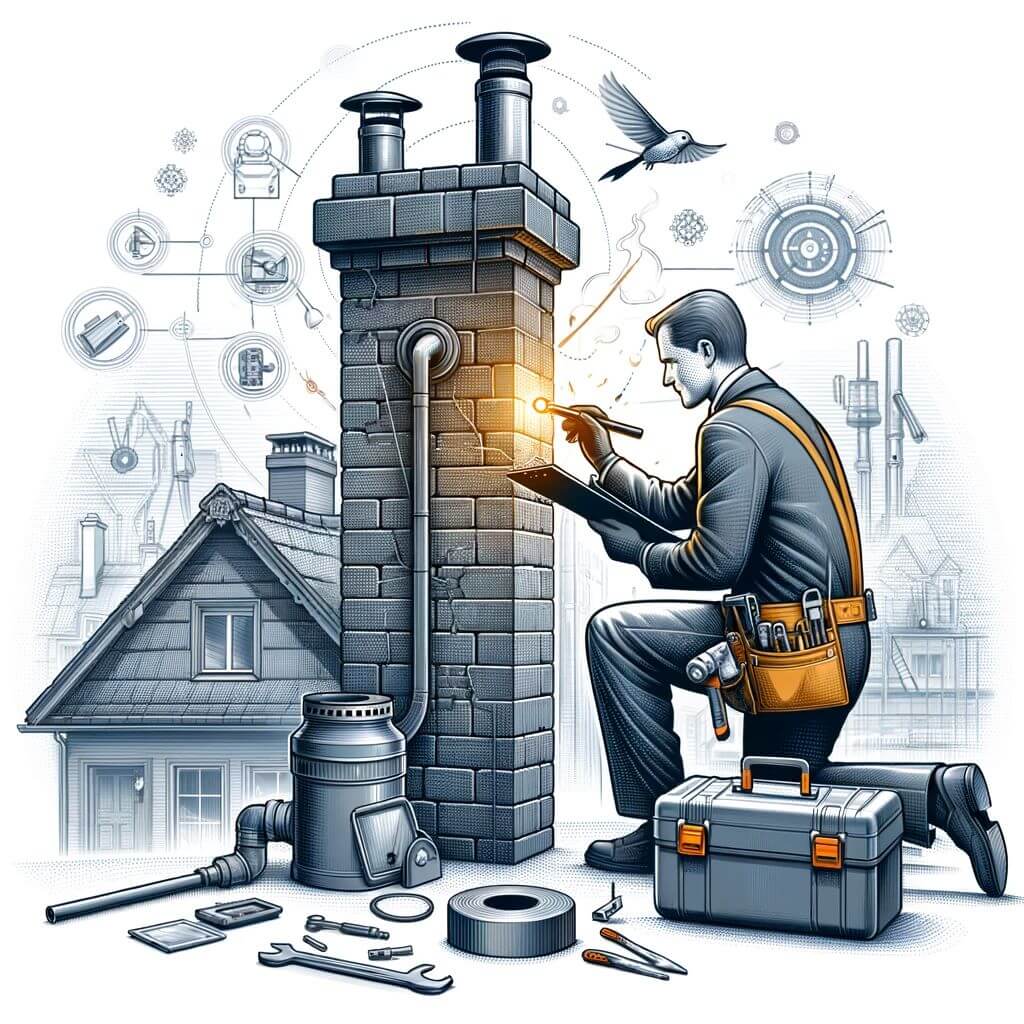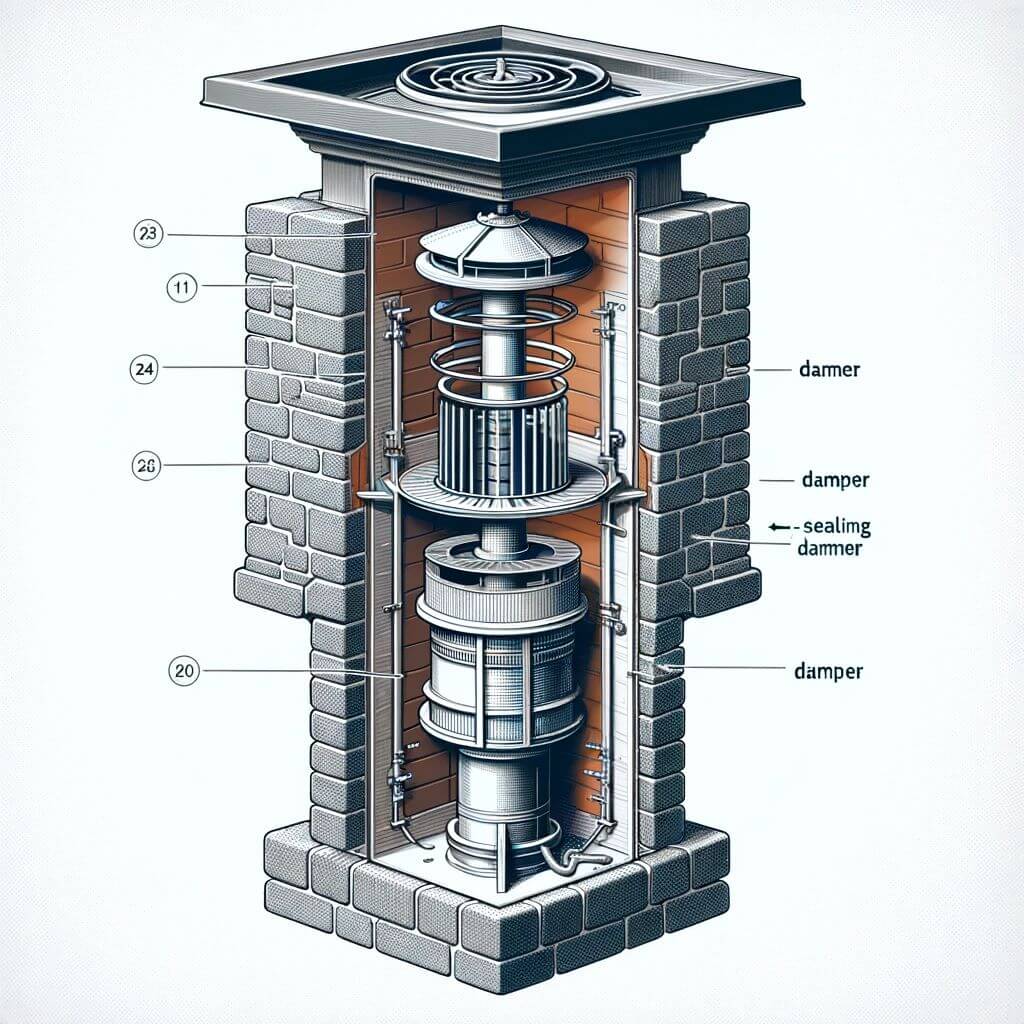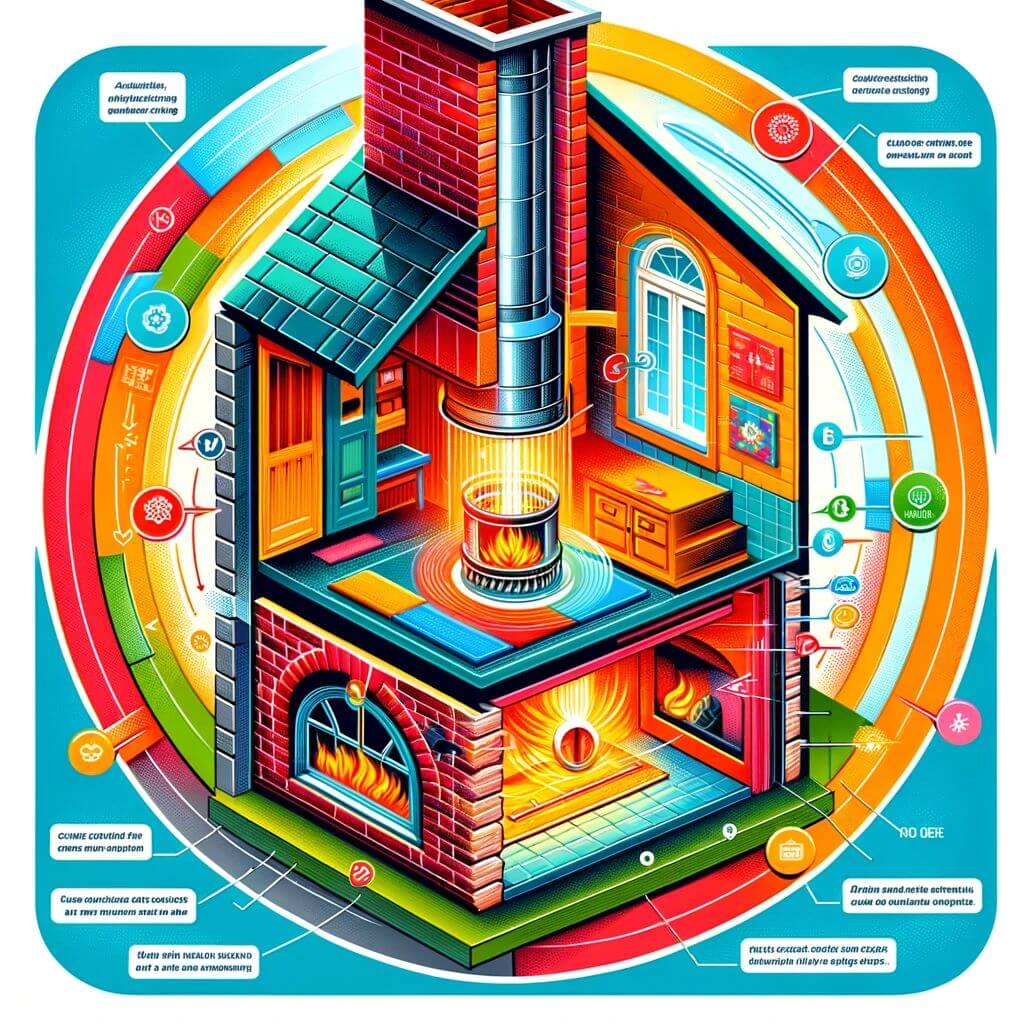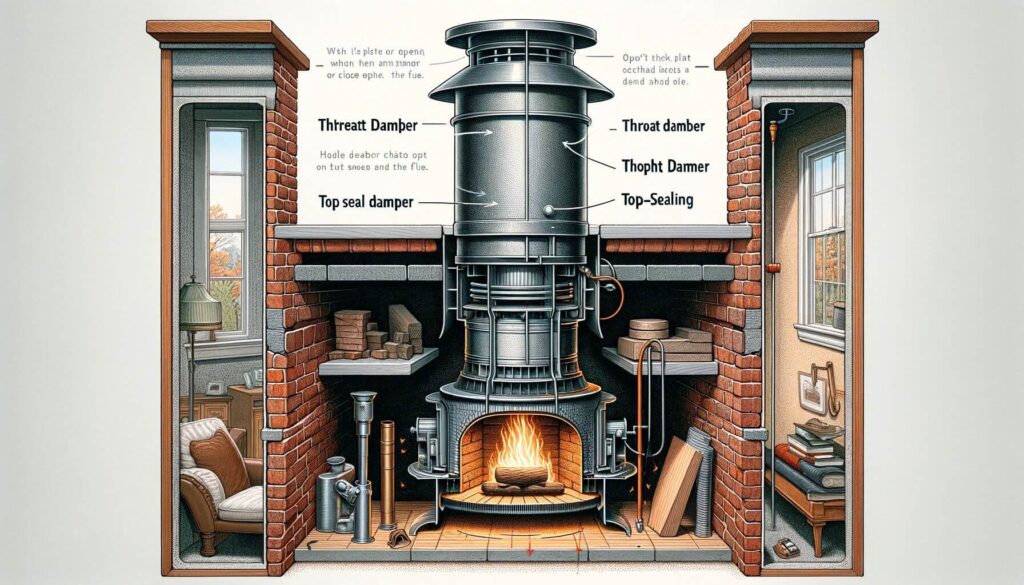
What is a Chimney Damper?
A chimney damper is a mechanical device located within the chimney structure, designed to regulate the flow of air and smoke through the chimney stack. Essentially, it acts as a valve or barrier in the chimney’s throat (where the fireplace and chimney meet) or at the top of the chimney. Its primary function is to seal the chimney when it is not in use and to open it when a fire is burning.

When a fireplace is in operation, opening the chimney damper allows smoke, toxins, and combustion byproducts to escape safely outside the home. This is critical for maintaining good air quality indoors and ensuring the safe operation of the fireplace. Conversely, when the fireplace is not in use, closing the damper prevents external air from entering and indoor heated or cooled air from escaping through the chimney. This control over air movement is crucial for maintaining comfortable indoor temperatures and reducing energy wastage.
Role in Controlling Airflow and Energy Efficiency
The efficiency of a chimney damper lies in its ability to control the home’s internal climate. By preventing the escape of warm air during colder months and keeping hot air out during warmer months, a well-functioning damper contributes significantly to energy efficiency. This not only translates to a more comfortable living environment but also results in noticeable savings on energy bills. The ability to regulate airflow also means better control over the intensity and duration of the fire in the fireplace, which can be a crucial aspect in terms of safety and fuel usage.
Historical Context: Evolution of Chimney Dampers
The evolution of chimney dampers reflects a history of adaptation and innovation in response to changing heating technologies and architectural styles. The earliest forms of chimney dampers were rudimentary, often made from simple metal plates that could be shifted to cover or uncover the chimney opening. These were manually operated and lacked precision in airflow control.
As home heating technologies advanced, so did the design and functionality of chimney dampers. The 19th and 20th centuries saw significant improvements in damper designs, with the introduction of pivoting metal plates and later, cast-iron dampers that provided better sealing and more accurate control. The concept of top-sealing dampers, which are placed at the very top of the chimney, is a more modern development. These dampers offer improved sealing capabilities and efficiency, especially in preventing downdrafts and keeping out animals or debris.
The history of chimney dampers is not just a tale of technological advancement but also one of increasing awareness about energy efficiency and home safety. As environmental concerns and energy costs have risen, so has the focus on improving the efficiency of these essential components. Today, chimney dampers are an integral part of a home’s heating system, reflecting centuries of innovation aimed at enhancing comfort, safety, and efficiency.
Types of Chimney Dampers

Let’s discover the type of dampers and why are they used for:
Throat Dampers
Description and Common Uses: Throat dampers are traditionally located in the “throat” of the chimney, just above the fireplace. They are typically constructed from metal and operate on a pivot or a pulley system. This type of damper is manually controlled, usually with a handle or a lever that opens and closes the damper plate.
Advantages:
- Cost-Effective: Throat dampers are generally less expensive to install, especially in new chimney constructions.
- Simplicity: Their design and mechanism are simple, making them easy to use and understand.
- Direct Control: Being located close to the fireplace, they offer immediate and direct control over the airflow.
Disadvantages:
- Less Effective Seal: Over time, throat dampers can become less effective at sealing due to warping, rust, or soot accumulation.
- Maintenance Requirements: They require regular cleaning and maintenance to function properly.
- Inconvenience: Manual operation may be less convenient compared to more modern systems.
Top-Sealing Dampers
Description and Differences from Throat Dampers: Top-sealing dampers are located at the top of the chimney. They function similarly to a throat damper but are operated by a cable running down the chimney to the fireplace. When closed, they provide a seal at the chimney’s top, using a rubber or silicone gasket.
Advantages:
- Better Seal: They offer a more effective seal against weather, debris, and animals, reducing drafts and heat loss.
- Energy Efficiency: By sealing the chimney top, they prevent warm air from escaping in winter and cool air in summer, improving energy efficiency.
- Durability: Typically more durable as they are less exposed to intense heat and corrosive byproducts of combustion.
Disadvantages:
- Higher Initial Cost: They can be more expensive to install, especially in existing chimneys.
- Professional Installation Required: Installation is more complex and often requires professional service.
Comparative Analysis: When to Choose One Over the Other
- Choose a throat damper if cost is a significant factor, especially in new constructions where installation is straightforward.
- Opt for a top-sealing damper for improved energy efficiency, better sealing against elements, and long-term durability. It’s particularly beneficial in older homes where existing throat dampers might be inefficient.
Importance of Chimney Dampers in Fireplaces

Enhancing Fireplace Efficiency
Chimney dampers play a vital role in enhancing the efficiency of a fireplace. By controlling the amount of air that escapes through the chimney when the fireplace is not in use, dampers significantly reduce heat loss. This is crucial in maintaining a comfortable temperature in the home and minimizing the workload on heating systems, thereby saving on energy costs.
Safety Considerations
The functionality of chimney dampers is also tied to safety:
- Preventing Downdrafts: A properly functioning damper prevents downdrafts, which can blow smoke and harmful gases back into the living space.
- Chimney Fire Prevention: By controlling the oxygen supply to a fire, dampers can help in preventing chimney fires, which often occur due to excessive buildup of combustible byproducts like creosote.
Regulatory Aspects
Building codes and standards often include specific requirements for chimney dampers:
- Compliance with Safety Standards: Regulations may dictate the types of dampers that must be used in certain types of buildings or in specific geographical areas.
- Installation and Maintenance: Building codes often require that dampers be installed and regularly maintained by qualified professionals to ensure they operate safely and efficiently.
- Emissions Control: In some regions, dampers are mandated as part of efforts to reduce air pollution from wood-burning fireplaces.
As a homeowner, it is important to understanding these regulations to ensure that your fireplace systems are not only efficient and safe but also legally compliant with your local ordinance.
Installation and Maintenance

It is always advised to seek the help of a professional. Nevertheless, we will see some information to help you do it yourself.
Professional Installation vs. DIY
Guidelines:
- Professional Installation: Recommended for top-sealing dampers due to the complexity and the need for working at heights. Professionals have the necessary tools and expertise to ensure a secure and effective installation.
- DIY Installation: More feasible for throat dampers, especially in new constructions. However, a good understanding of fireplace and chimney anatomy is essential.
Tools Required:
- Basic tools for DIY might include a screwdriver, wrench, drill, and sealant. For top-sealing dampers, additional specialized tools and safety equipment for roof access may be needed.
Safety Tips:
- Always prioritize safety, especially when working at heights.
- Ensure the fireplace is completely extinguished and cool before starting any work.
- Wear protective gear, including gloves and eye protection.
Routine Maintenance
- Cleaning: Regular cleaning of the damper is crucial to remove soot, debris, and creosote buildup.
- Inspection: Annual inspection by a professional is recommended to check for wear, corrosion, or mechanical issues.
- Common Issues to Watch For: Look for signs of rust, warping, or difficulty in opening and closing the damper.
Lifespan and Replacement
- Lifespan: The lifespan of a chimney damper can vary but typically lasts several years depending on usage and maintenance.
- When to Replace: Indicators for replacement include significant corrosion, structural damage, or persistent operational issues.
- Why Replace: A fully functional damper is essential for energy efficiency, safety, and proper ventilation of the fireplace.
Necessity of Chimney Dampers

Chimney dampers are essential for several reasons beyond just energy efficiency and safety. They play a critical role in maintaining indoor air quality by preventing outside air pollutants, animals, and debris from entering the home through the chimney. This is crucial for homes in both urban and rural settings, where environmental factors differ greatly.
Operational Guidance for Chimney Dampers
Closing the Chimney Damper: The chimney damper should be closed once the fireplace has cooled completely after use. This prevents conditioned indoor air from escaping through the chimney. So, maintaining the home’s thermal comfort without overburdening heating or cooling systems.
Damper Position and Fire Management: A damper should be fully open when starting a fire to ensure proper draft and smoke evacuation. Once the fire is established, slightly adjusting the damper can control the burn rate and heat output. However, it should never be fully closed while the fire is burning to avoid smoke spillage into the room.
Fireplace Flue vs. Damper
The fireplace flue is the vertical channel through which smoke and combustion gases are vented to the outdoors. In contrast, the damper is a movable plate situated within the flue or at its entrance (throat damper) or exit (top-sealing damper) that regulates the flow of air and smoke. Understanding this distinction helps in proper maintenance and operation.
Visual Identification of Dampers
Fireplace dampers can vary in appearance based on their type and design. Throat dampers usually have a metal plate that pivots or slides to open or close the flue, often controlled by a lever or chain. Top-sealing dampers, conversely, are located at the chimney’s top and may have a rubber or silicone seal visible from the outside, with a cable running down into the fireplace for operation.
Seasonal Damper Management
Summer Considerations: During summer, the strategy for damper management depends on your home’s specific needs. Closing the damper can prevent warm air intrusion and reduce unwanted heat gain. However, in some climates, leaving the damper slightly open can facilitate air circulation and prevent mustiness in the chimney.
Damper Use in Older Chimneys: Older chimneys might not have originally been equipped with dampers, or they may have outdated or inefficient designs. For these cases, retrofitting with a new top-sealing damper can enhance both functionality and safety.
Addressing Homes Without Dampers
In homes where a fireplace damper is absent or infeasible to install, alternative solutions like chimney balloons or vent covers can temporarily seal the chimney. However, these are not substitutes for the benefits provided by a proper damper and should be considered short-term fixes.
Cost Considerations
The installation cost for a chimney damper can vary widely based on the damper type, chimney design, and whether professional installation is required. Throat dampers might be less expensive and easier to install in new constructions, whereas top-sealing dampers might require professional installation, especially in existing chimneys, with costs potentially ranging from a few hundred to over a thousand dollars.
Recognizing Open or Closed Dampers
An open damper typically allows you to see daylight through the chimney flue or feel a draft if the firebox is cold. Conversely, a closed damper will block this view and prevent air movement. For precise control and safety, it’s vital to verify the damper’s status before lighting a fire.
Common Problems and Troubleshooting

Now let’s look at common problems with fireplace dampers and how to troubleshoot:
Stuck or Frozen Dampers
- Causes: Accumulation of soot and creosote, rusting, or warping due to heat exposure.
- Solutions: Regular cleaning can prevent this issue. If the damper is already stuck, a professional cleaning and lubrication of the mechanism might be necessary.
Leakage Issues
- Identifying Air Leaks: Feel for drafts or use smoke from incense to see if air is passing through a closed damper.
- Fixing Air Leaks: Ensure the damper fits properly. For top-sealing dampers, check and replace the gasket if worn out. If misalignment is the issue, a professional adjustment may be required.
Noise Problems
- Causes of Rattling Noises: Loose parts, improper alignment, or damage due to wear and tear.
- Addressing the Noise: Tightening loose components or applying lubricant can help. If the noise persists, it may indicate the need for professional repair or replacement.
Proper installation and diligent maintenance of chimney dampers are crucial for their efficient and safe operation. Being proactive in addressing common problems and seeking professional help when necessary can significantly extend the life of your chimney damper, ensuring a safe and comfortable home environment.
Advanced Considerations in Fireplace Dampers System
Energy Efficiency
A well-functioning chimney damper is a key component in enhancing a home’s energy efficiency. By preventing warm air from escaping the house through the chimney when the fireplace is not in use, a damper can significantly reduce heating costs. During warmer months, it prevents hot air from entering the home, thereby reducing the workload on air conditioning systems. This controlled air exchange ensures that energy is used efficiently, leading to lower utility bills and a more comfortable living environment.
Environmental Impact
Chimney dampers also play a crucial role in reducing environmental impact. By improving the efficiency of fireplaces and wood stoves, they help minimize the amount of wood burned and reduce smoke and particulate emissions. This is particularly important in urban areas, where air quality regulations may be stringent. A properly functioning damper ensures more complete combustion, thus decreasing the release of harmful pollutants into the atmosphere.
Innovations and Future Trends in Damper Technology
The chimney damper industry continues to evolve with advances in technology and materials. Innovations such as automated or smart dampers, which can open and close based on temperature or whether a fire is burning, are becoming more prevalent. These smart dampers can be integrated into home automation systems, offering greater convenience and efficiency.
Materials used in damper construction are also improving, with the development of more durable, heat-resistant, and corrosion-resistant components. Looking forward, we can anticipate further integration of eco-friendly materials and advanced control systems that align with the growing demand for sustainable and energy-efficient home heating solutions.
Thus, understanding the common problems associated with chimney dampers and staying abreast of the latest advancements in damper technology are essential for maintaining a safe, efficient, and environmentally friendly fireplace or wood stove system.
Frequently Asked Questions
- How do I know if my chimney damper is open or closed?
- Typically, you can feel a draft when the damper is open. If your fireplace has a control lever or handle, its position often indicates the damper’s status. In some cases, visual inspection using a flashlight might be necessary.
- Can I install a chimney damper myself, or should I hire a professional?
- While DIY installation is possible, especially for throat dampers, it’s often recommended to hire a professional for safety reasons and to ensure proper installation, particularly for top-sealing dampers.
- How often should chimney dampers be inspected or maintained?
- Chimney dampers should be inspected and maintained at least annually, preferably by a professional chimney sweep, to ensure they are in good working condition.
- Are there any signs that indicate my chimney damper needs replacement?
- Signs include difficulty in operating the damper, visible rust or damage, persistent drafts even when the damper is closed, and unusual noises.
- Do all types of fireplaces require a chimney damper?
- Most traditional wood-burning fireplaces require a chimney damper. However, some modern gas fireplaces and certain types of heating systems may not.
- How does a chimney damper improve the efficiency of a fireplace?
- By controlling the flow of air in and out of the chimney, a damper helps maintain desired indoor temperatures, reduces heat loss when the fireplace is not in use, and improves the combustion efficiency when it is in use.
- Can a faulty damper contribute to higher energy bills?
- Yes, a faulty or improperly sealed damper can allow heat to escape in the winter and warm air to enter in the summer, leading to higher energy bills.
- Is it safe to operate a fireplace with a damaged damper?
- Operating a fireplace with a damaged damper can be unsafe. It can lead to poor ventilation, risk of carbon monoxide buildup, and reduced efficiency.
- What are the most common materials used in chimney damper construction?
- Common materials include metal alloys like stainless steel or aluminum for their durability and resistance to heat and corrosion.
- Are there any smart or automated chimney dampers available?
- Yes, there are smart or automated dampers that can open and close based on temperature settings or whether a fire is detected. These are integrated with home automation systems for enhanced convenience and efficiency.
Final Thought
In this article, we have explored the crucial role of chimney dampers in residential heating systems. From understanding the basic functions and types of chimney dampers to recognizing their importance in enhancing fireplace efficiency and safety, we have covered a comprehensive range of topics. We also delved into installation, maintenance, and troubleshooting common damper problems, highlighting the significance of professional expertise in these areas.
Moreover, we addressed advanced considerations, such as energy efficiency, environmental impact, and innovations in damper technology. Through the frequently asked questions, we aimed to resolve common queries and misconceptions regarding chimney dampers.
Understanding and maintaining chimney dampers is not just about ensuring a comfortable and energy-efficient home; it’s also about safeguarding the safety and well-being of the household. Whether you are a homeowner, a DIY enthusiast, or simply seeking to broaden your knowledge, this guide serves as an essential resource for appreciating the value and functionality of chimney dampers in your fireplace system.



